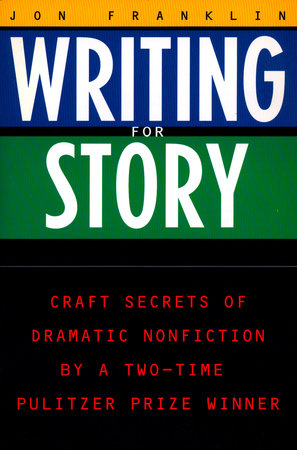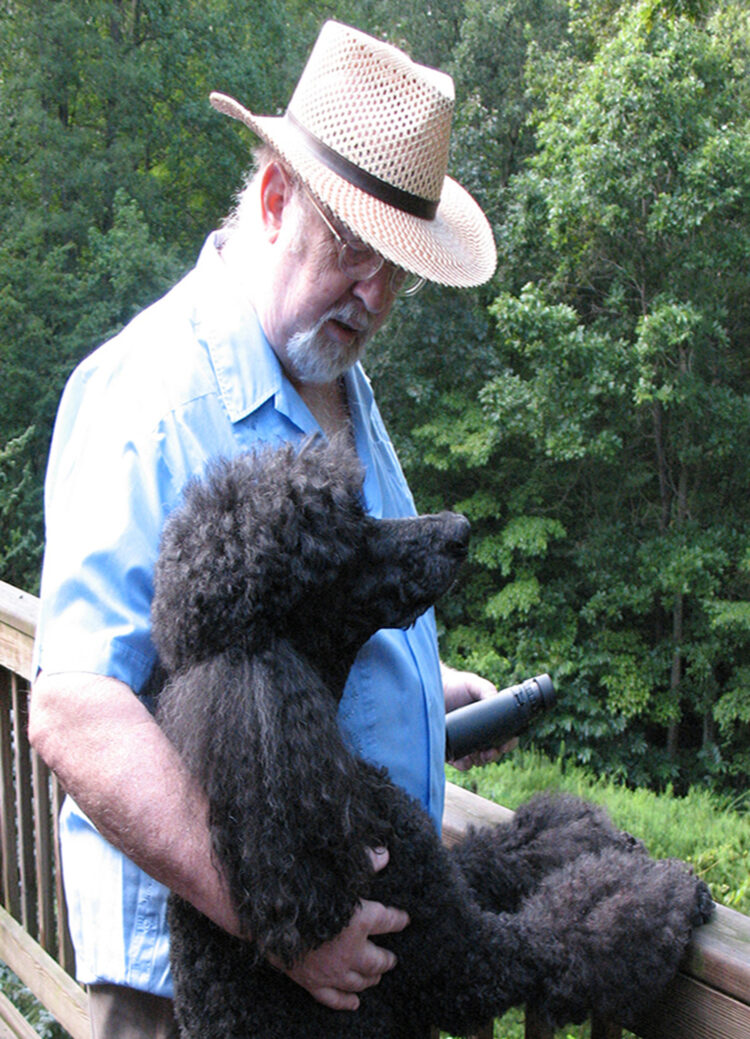Jon Franklin, winner of two Pulitzer Prizes and an author and teacher who fomented the late-20th century revolution of literary journalism in American newspapers, died Jan. 21 in Annapolis, Maryland. He was 82.
Franklin died at Hospice of the Chesapeake after a Jan. 8 fall at home, said his wife, writer Lynn Franklin. In the past two years, he had undergone treatment for esophageal cancer.
From coast to coast for four decades, Jon Franklin’s byline heralded a new path for journalists seeking to create the art of real life. With his landmark 1986 book, “Writing for Story,” Franklin pushed news writers to seize the literary tools of Chekhov and Steinbeck and build “chronologies of meaning” on the foundation of newsgathering.
“Jon Franklin proved to a generation of journalists that good reporting could gain the power of literature,” said Roy Peter Clark, nationally renowned author and writing coach at the Poynter Institute in St. Petersburg, Florida.
“Jon Franklin is a legend among my colleagues,” said Jack Hart, retired managing editor and writing coach at The Oregonian. “‘Writing for Story’ was a breakthrough that articulated for the first time a coherent strategy of how story theory applied to the world of nonfiction, and it forever changed the practice of journalism.”
Writer Adina Gewirtz of Silver Spring, Maryland, a longtime friend of the Franklins, said Franklin “changed my life, and I know I’m not the only one.”
“Jon wanted to be the teacher of a lifetime,” Gewirtz said. “He was passionate about the truth and the power of story to tell it, and he loved his students long after they’d left the classroom. We loved him back.”
Building an online community of nonfiction writers
In addition to his newspaper work and seven books, Franklin pioneered the internet’s potential for connection. In 1994, Jon and Lynn Franklin established the list serve WriterL, a virtual salon about literary journalism. Over 15 years, WriterL grew into a lively exchange that a New York Times story likened to Paris in the 1920s.
With Jon instigating and Lynn moderating WriterL, more than 400 writers and editors, many of them award-winning practitioners, worked over the big questions at the crossroads of art and daily journalism. What is the suspension of disbelief in nonfiction? When is the best use of the first person? How does a writer begin?
But one subject above all occupied WriterL: What is truth, anyway? Critics of the genre complain that literary journalists don’t let the facts get the way of a good story. In one typical response, Franklin countered that every word in a work of literary journalism arises from the reporter’s quest for the facts.
“You use the facts to find your point in the story. You report for story. The reason for the self-examination is so that you can take yourself out and in that way clear away some of the clutter in a perfectly legitimate fashion,” he wrote. “That is how you ‘service’ your point, except that it’s the story’s point. It’s the jewel you’ve done all your reporting for.”
In 2022, veteran editor Stuart Warner and the Franklins compiled a book of WriterL’s best threads. In his introduction to “A Place Called Writer,” Warner writes the book brings together “robust conversations about the art of nonfiction writing that may have taken place 15 or 20 years ago but are still relevant and enlightening to writers today.”
The “school” of Fitzgerald and Hemingway
A hard Oklahoma boyhood kept Franklin from pursuing the education to fulfill his dream of becoming a scientist. Instead, he enrolled in what he called the “universal school for writers” — the novels of Fitzgerald and Hemingway, and the short stories in the Saturday Evening Post and other popular magazines of postwar America.
The currents of science and literature carried Franklin to the Baltimore Evening Sun, where the science beat had sat open, ignored. Franklin claimed it and made it into a showcase of reader-pleasing narratives. In 1979, he earned the first Pulitzer Prize awarded for feature writing for “Mrs. Kelly’s Monster,” a story about a brain surgeon and his patient. In 1985, he earned the inaugural Pulitzer for explanatory journalism for “The Mind Fixers,” a seven-part chronicle on the dawn of molecular psychiatry.
Setting the bar in two Pulitzer categories established Franklin as a master of the craft, a sought-after teacher and speaker. “Mrs. Kelly’s Monster” rests at the cornerstone of journalism curricula nationwide. The tightly engineered medical narrative reminded reporters that readers love newspaper stories that make their hearts pound. Most prize-winning journalism since emulates the approach of “Mrs. Kelly’s Monster.”
“Jon Franklin fused the modern discipline of journalism with the ancient magic of storytelling to create a new literary genre capable of bridging the gap between the sciences and the humanities that has long divided mainstream culture,” said Seattle writer John Higgins, a Franklin student and friend of three decades.

Franklin then published his definitive how-to book, and its title baldly announced the contents: “Writing for Story: Craft Secrets of Dramatic Nonfiction By a Two-Time Pulitzer Prize Winner.” The book is his best seller and remains in print after nearly 40 years. In many writers’ libraries, “Writing for Story” is shelved between a dictionary and “The Elements of Style,” by William Strunk and E.B. White.
But Franklin’s book rarely stays on a writer’s shelf for long.
“I purchased the book shortly after it appeared, put its lessons into practice and can testify to its power,” writing teacher Chip Scanlan of the Poynter Institute wrote in 2019. “To prepare for a new writing project, I recently dove back into my copy. I was pleased to see that it was just as instructive and inspirational as I remembered.”
“The book certainly changed my outlook on the literature of fact,” said Jack Hart, who oversaw the work of five Pulitzer Prize winners at The Oregonian. For his own book, “Storycraft: The Complete Guide to Writing Narrative Nonfiction,” Hart said, “I quoted nobody more than Jon Franklin.”
Author Walt Harrington, a longtime Washington Post Magazine writer, University of Illinois journalism professor and WriterL member, said Franklin’s gift was tearing away the mystique about writing.
“ ’Writing for Story’ revolutionized newspaper feature journalism by establishing that the narrative arc of an unanswered thematic question to be answered at the end could drive nearly every feature story,” he said. “Tom Wolfe and the other historic New Journalists had implied it and illustrated it. But Jon made it a method that could be taught and replicated by mere mortals.”
Fighting back with words
Born Jan. 13, 1942, in Enid, Oklahoma, Jon Daniel Franklin was the first son of Wilma and Benjamin Max Franklin, an itinerant construction electrician who picked fights in honkytonks. But his father encouraged his son’s interest in writing.
In “Writing for Story,” Franklin writes of getting bullied as a teenager then talking all night with his father, who counseled fighting back with words. By dawn, “I had become a real grown-up revolutionary, and later we went out together, and he bought me a beat-up Underwood.”
Franklin rarely stayed in the same school for more than six weeks as the family moved around for his father’s work. He quit high school to join the Navy. His writing ability got him orders to All Hands magazine, the Navy’s glossy journal of profiles and photographs, published at the Pentagon.
There, Franklin learned journalism from seasoned editor G. Vern Blasdell, who delivered the hard basics like boot camp. Franklin sweated over each story to earn a mere nod from the demanding Blasdell until “the day finally came that he told me he could teach me no more,” Franklin wrote in “Writing for Story.” “I was as sad as I was the day he died a decade later.”
With the Vietnam War escalating, Franklin mustered out of the Navy after eight years, and the G.I. Bill allowed him to be the first in his family to go to college. He earned a bachelor’s degree in journalism from the University of Maryland in 1970. He wrote first for the Prince George’s Post then for the Baltimore Evening Sun, once the home of legendary columnist H.L. Mencken.
In a newsroom, reporters compete fiercely for the high-visibility assignments in politics and sports. For Franklin, science was the only frontier worth patrolling. But to his eternal frustration, newspapers too often did the easy thing and celebrated the trivial.
Franklin the revolutionary needled editors for chasing bright shiny objects instead of stories of real life. Even more infuriating was the routine mishandling of science news that Franklin said contributed to the nation’s illiteracy about science, “nothing less than the deconstruction of the Enlightenment.”
After his second Pulitzer Prize, he moved into the classroom, first at what was then Towson State University then at the University of Maryland-Baltimore County, then at his alma mater where he became a full professor.
“It’s a hard road for people who are trying to write the true literature of what’s happening in society,” he told College Park magazine in 2001. “Are rock stars really our heroes? I don’t think so. They have their place, but they shouldn’t be the big story. The main event is life, and that’s the principle I want to make sure students are exposed to.”
Blunt story coaching
In Baltimore, Franklin met Lynn Scheidhauer, a writer at a local college, and they married in 1988. The next year, the Franklins went west for Jon to head the journalism program at Oregon State University. Later, he went to the University of Oregon to teach journalism and serve as director of creative writing.
Hart, the retired Oregonian editor, said Franklin was generous with time and praise “for those who he felt understood and supported the cause of bringing the storyteller’s craft to telling the tales of ordinary people facing the challenges of everyday life.”
When Tom Hallman Jr., was the police reporter for The Oregonian, he once drove three hours to Corvallis to present his work to the master. Hallman sweated as Franklin liberally applied the red pen.
“He offered no pep talk, no words of encouragement, just a blunt assessment: If you want to tell stories, you have study structure and do the work to learn story,” Hallman said. “I returned to my car, embarrassed. I could pretend I’d never came to meet Franklin. I could pretend he’d never marked up my work.”
Instead, Hallman dived into the discipline. “I began reporting differently, thinking not of the words on the page but the arc of the character and the story. When I started winning national feature awards, I’d get an email from Franklin. In time, I won all of them, including the 2001 Pulitzer Prize for feature writing. When it was announced, Franklin called to congratulate me, telling me I was now in the club.”
In 1998, Franklin was lured back into the newsroom. He and Lynn left Oregon for North Carolina, where Jon became science writer for the News & Observer in Raleigh, then building a reputation as a writer’s paper.
In editor Trish Wilson, Franklin met his match. She had read “Writing for Story,” and she told a newsroom gathering that she was glad for a reporter who came with an instruction manual.
With Wilson editing, Franklin wrote “A Death in the Family,” a compelling, insightful drama about the scientists at the Duke Primate Center in Durham, North Carolina, who cared for the center’s colony of lemurs. Lynn Franklin said she considers that story her husband’s masterpiece.
Newsroom to classroom and back again
The Franklins aimed to retire in North Carolina with a succession of black standard poodles. But in 2001, the University of Maryland offered Jon Franklin an endowed position, the first Merrill Chair in Journalism. The Franklins moved once more, to a house in the pine woods of Sunderland, Maryland, just west of the Chesapeake Bay.
They had barely unpacked when one night in 2003, their poodle Sam barked them awake. The house was ablaze and filled with smoke from an electrical fire, and the Franklins fled with only the robes on their backs.
They spent two years rebuilding the house and their lives. Jon wrote about the fire in his 2009 study of the human-dog bond, “The Wolf in the Parlor: The Eternal Connection Between Humans and Dogs”:
“A wave of smoke washed over us; Sam sneezed, and I began to cough. Together, as if choreographed, we turned and walked back down the long driveway leaving the shouting men, the snaking hoses and collapsing walls behind. Lynn reached across Sam, who was trotting between us, and took my hand. I squeezed her fingers. Life would go on.”
From Oregon to North Carolina to Maryland, WriterL went on, too. The conversation started in 1994, when Jon Franklin asked Oregon State computer technologists to build a list serve. Soon, word spread about the rollicking, almost-daily online debates about writing with opinionated participants.
But after 15 years, the creation of the internet was in turn a victim of the internet. By 2009, social media had exploded, and WriterL’s threads got thinner and less frequent.
“It hurt to stop,” Lynn Franklin said. “It was a painful decision. People became like family.”
Even after his retirement from the University of Maryland in 2010, Franklin coached writers. In 2019, the Franklins moved to Annapolis. At his death, Jon Franklin was working on a memoir of his Oklahoma boyhood.
A lifetime of stories
In addition to “Writing for Story,” “The Wolf in The Parlor” and “A Place Called WriterL,” Franklin also wrote:
- “Guinea Pig Doctors: The Drama of Medical Research Through Self-Experimentation,” in 1984 with Dr. John Sunderland.
- “Shocktrauma: The Dramatic True Story of a Pioneering Hospital Team to Conquer the Most Lethal Killer of All,” with Alan Doelp, a 1985 work of dramatic nonfiction that was turned into a Canadian television film.
- “Not Quite A Miracle: Brain Surgeons and Their Patients on the Frontier of Medicine” in 1983, also with Doelp.
- “Molecules of the Mind: The Story of the Psychological Discovery that Changed the World,” a New York Times Notable Book of the Year in 1987.
Franklin received honorary degrees from the University of Maryland in 1981 and Notre Dame de Namur University in 1982. In 1985, the American Chemical Society bestowed on Franklin its James T. Grady Award, once given to Isaac Asimov. In 1986, Franklin was a semifinalist in NASA’s Journalist In Space program.
Survivors include his wife of 43 years, Lynn, of Annapolis, his daughter Catherine Franklin Abzug, and her husband Morty Abzug. Franklin’s parents and younger brother Douglas predeceased him.
Contributions in Jon Franklin’s name may be made to Hospice of the Chesapeake, Annapolis, Maryland.
* * *
Anne Saker is a retired newspaper journalist. Papers she reported for include the Raleigh (North Carolina) News & Observer, the (Portland) Oregonian and the Cincinnati Enquirer.



